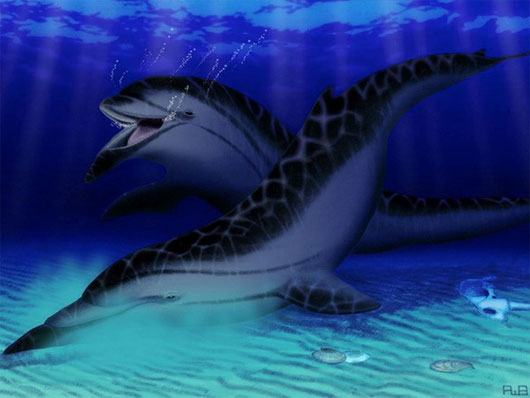The ancient mammal has a long lower jaw and unusually protruding
The remnants of an extinct dolphin species have long shown that these aquatic mammals once had long lower jaws and protruded out abnormally. This is a new announcement published in the latest issue of Current Biology.
The ancient dolphin with the scientific name Semirostrum ceruttii used to live in the current California waters from between 1.6 and 5 million years ago. The researchers said that the species used its very long snout to hunt for food.
"This extinct dolphin is a completely new and very strange animal, with its lower jaw sticking out of a long muzzle like a bird's beak. They probably used a long snout to probe and 'surf'. in the water " , co-author Rachel Racicot of Yale University said in a press conference. "Although this pattern has been recorded in birds and fish, this is the first time that a mammal has this anatomical form."

Semirostrum ceruttii dolphin(Photo: discovery.com)
Racicot birds and fish mentioned include black-tailed fish and small fish with the last name. They all have lower jaws longer than the upper jaw, helping them to eat during the night or in low light conditions.
Traces of new mammals were first found in new rock formations along the California coast in 1990. Recent CT scans have revealed an anatomical form of this species.
In addition to long jaws, their eyes are smaller than modern dolphins. Therefore, it is possible that the sight of this mammal is relatively poor, making the lower jaw become more important in their search for food.
Researchers believe that this dolphin has certain similarities with freshwater dolphins today.
"Today we do not find any animals like freshwater dolphins in the same conditions as Semirostrum species , " Racicot stressed, that the fish may have grown increasingly specialized over time.
She and her colleagues also said that more and more new animals will be found, thanks to 3D imaging technology that allows long-term analysis of extinct animals thanks to the stored specimens. hold for decades.
"Many newly identified animals need to be described and analyzed still in museums, but such detailed descriptions also need a lot of time," Racicot said.
- Discover the oldest mammal
- Surprised by the scientific facts about ... the belly button
- Myrmecophaga tridactyla
- Tooth bone tumors cause many people to fear cancer
- Determine the owner of ancient Han dynasty thanks to jade
- Mammal ancestors take advantage of extinction events
- The largest carnivorous mammal on land, dubbed the 'mobile meat grinder'
- England: An unusually long winter is caused by the sun's activity
- Long-nosed fish, like the wings of Canadian fishermen
- Causes of lower back pain near the buttocks and how to handle them
- Long tongue bats: speed champion digest food!
- How long ice tray nowhere?
 Discovered an ancient centipede fossil 99 million years old
Discovered an ancient centipede fossil 99 million years old Discovered bat-like dinosaurs in China
Discovered bat-like dinosaurs in China Discovered a 200-year-old bronze cannon of the coast
Discovered a 200-year-old bronze cannon of the coast Discover 305 million-year-old spider fossils
Discover 305 million-year-old spider fossils